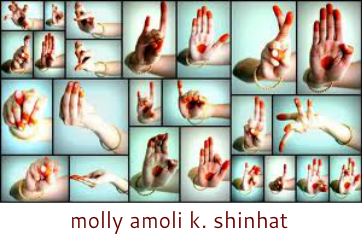Diana Thorneycroft: The body, its lesson and camouflage
(126 pps., published by Bain & Cox, Winnipeg, 2000, $60.00)

"No image available" book cover for DT's book, copyright Amazon.com
"Oh... absolutely not. I've never ever considered that," says photographer Diana Thorneycroft. "It's a really good question, but I've never thought of that. I talk about my work as a performance for an audience of one.... but the idea of being an actor - I just don't have that kind of courage."
To my mind, it's the obvious question that apparently she's never been asked before. All of her photographs are about roles and role-playing, if nothing else.
For a photography book, this one leans heavily on the written word. No less than three essays and an interview take up most of the book. The photo critic of the New York Times and a professor at City University of New York (another American) contributed essays. Robert Enright, photography book reviewer for The Globe & Mail and editor-at-large for the art magazine, Border Crossings, did a lengthy interview with the artist, and the book's editor, Meeka Walsh, editor of Border Crossings, contributes her own essay.
Having come up with the idea for the book, Walsh edited it too. It features about 40 plates, covering the last decade of Thorneycroft's work.
Unfortunately text-heavy art monographs tend to encourage us to "agree with the experts". There's little room for art to do something meaningful—like provide us with questions, make us think or feel, for ourselves, on our own terms. Art's too busy being used as a whore to prostitute certain ideas to our minds.
Since Thorneycroft's work is about transgression on so many levels, the voluminous explanatory and contextual material may help. Still, it's ironic that a book couldn't be devised to match the apparent transgression in Thorneycroft's work. With a print run of one thousand and ringing in at $60 a piece, it's definitely a coffee table book for the coffee table public, with high quality reproductions and arty essays to match.
Be warned. You may find the images disturbing. Filled with scenes of bound naked people, usually women (Thorneycroft herself), and elaborate sets featuring animal bones and skins, dolls, military paraphernalia, and old medical equipment, she turns herself and the male models into objects.
"When I make a work of art," says Thorneycroft, "I control between 40 - 50% of its meaning, the viewer concludes the rest of the meaning of the work. I am the subject and the object. I am making them, and I am in them."
But this "I-sound-like-a-thesis" subversion lasts only as long as the photo session. Upon the pictures' release through publication or exhibition, her control goes up in smoke. Anything can be done with or to them—and by extension, with or to Diana Thorneycroft. Her much touted "control" becomes worse than academic. It's gone.
She's treading the thin knife-edge between critiquing violence and violation in these photographs and perpetuating and beautifying it. It's not clear what her point is other than merely representing it. What clues does she gives us in the pictures?
Loosely divided into periods, the imagery includes scenes of torture, and bondage, and medical torture. Though not always sexually explicit, many photographs illustrate Thorneycroft's ongoing preoccupation—the "androgynous body" (She describes herself as "very flat-chested".).
"I couldn't tell if I was male or female," says Thorneycroft, recalling her response to her "Self-Portrait in Field of Dolls," 1989, "And I remember thinking, I can use this body to my advantage.... If I had the body of a Dolly Parton, I wouldn't do this."
You don't need a degree in biology to see the model in the picture is female. It's fascinating that Thorneycroft limits her work by the very male definitions of gender she's trying so hard to question, dismantle, blur or subvert.
"I don't want to use a model with really large breasts," she explains, "Because that would enter the realm of titillation." According to who? And yet she's quite willing to use identifiable dildos and male genitalia - "real men" can be part of her pictures. As (apparently) a straight woman, she reproduces some of the anxieties around gender typical to some men, some gay men especially. In those anxieties, women who look like women get put on pedestals, fucked or placed in states of erasure. It's all different manifestations of the same misogyny.
Thorneycroft describes her work as also "autobiographical". But her work references popular movies, the Alien series for instance, as much as academically fashionable theory or her own life experiences.
"If people are not left with answers," says Thorneycroft, "That's okay. I ask a lot of questions with my work, but I don't necessarily want people to walk away with answers."
Published in The Ottawa Xpress
To my mind, it's the obvious question that apparently she's never been asked before. All of her photographs are about roles and role-playing, if nothing else.
For a photography book, this one leans heavily on the written word. No less than three essays and an interview take up most of the book. The photo critic of the New York Times and a professor at City University of New York (another American) contributed essays. Robert Enright, photography book reviewer for The Globe & Mail and editor-at-large for the art magazine, Border Crossings, did a lengthy interview with the artist, and the book's editor, Meeka Walsh, editor of Border Crossings, contributes her own essay.
Having come up with the idea for the book, Walsh edited it too. It features about 40 plates, covering the last decade of Thorneycroft's work.
Unfortunately text-heavy art monographs tend to encourage us to "agree with the experts". There's little room for art to do something meaningful—like provide us with questions, make us think or feel, for ourselves, on our own terms. Art's too busy being used as a whore to prostitute certain ideas to our minds.
Since Thorneycroft's work is about transgression on so many levels, the voluminous explanatory and contextual material may help. Still, it's ironic that a book couldn't be devised to match the apparent transgression in Thorneycroft's work. With a print run of one thousand and ringing in at $60 a piece, it's definitely a coffee table book for the coffee table public, with high quality reproductions and arty essays to match.
Be warned. You may find the images disturbing. Filled with scenes of bound naked people, usually women (Thorneycroft herself), and elaborate sets featuring animal bones and skins, dolls, military paraphernalia, and old medical equipment, she turns herself and the male models into objects.
"When I make a work of art," says Thorneycroft, "I control between 40 - 50% of its meaning, the viewer concludes the rest of the meaning of the work. I am the subject and the object. I am making them, and I am in them."
But this "I-sound-like-a-thesis" subversion lasts only as long as the photo session. Upon the pictures' release through publication or exhibition, her control goes up in smoke. Anything can be done with or to them—and by extension, with or to Diana Thorneycroft. Her much touted "control" becomes worse than academic. It's gone.
She's treading the thin knife-edge between critiquing violence and violation in these photographs and perpetuating and beautifying it. It's not clear what her point is other than merely representing it. What clues does she gives us in the pictures?
Loosely divided into periods, the imagery includes scenes of torture, and bondage, and medical torture. Though not always sexually explicit, many photographs illustrate Thorneycroft's ongoing preoccupation—the "androgynous body" (She describes herself as "very flat-chested".).
"I couldn't tell if I was male or female," says Thorneycroft, recalling her response to her "Self-Portrait in Field of Dolls," 1989, "And I remember thinking, I can use this body to my advantage.... If I had the body of a Dolly Parton, I wouldn't do this."
You don't need a degree in biology to see the model in the picture is female. It's fascinating that Thorneycroft limits her work by the very male definitions of gender she's trying so hard to question, dismantle, blur or subvert.
"I don't want to use a model with really large breasts," she explains, "Because that would enter the realm of titillation." According to who? And yet she's quite willing to use identifiable dildos and male genitalia - "real men" can be part of her pictures. As (apparently) a straight woman, she reproduces some of the anxieties around gender typical to some men, some gay men especially. In those anxieties, women who look like women get put on pedestals, fucked or placed in states of erasure. It's all different manifestations of the same misogyny.
Thorneycroft describes her work as also "autobiographical". But her work references popular movies, the Alien series for instance, as much as academically fashionable theory or her own life experiences.
"If people are not left with answers," says Thorneycroft, "That's okay. I ask a lot of questions with my work, but I don't necessarily want people to walk away with answers."
Published in The Ottawa Xpress

